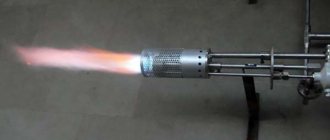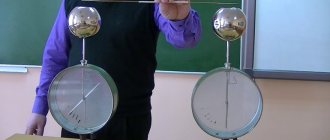Nikola Tesla is one of the most famous scientists in the field of electrical power and electricity, whose scientific legacy still causes much controversy. And if practically implemented projects are actively used and known everywhere, then some unrealized ones are still objects of research, both by serious organizations and amateurs.
Nikola Tesla
Self-production
So, the simplest way to make a Tesla coil for dummies with your own hands. Often on the Internet you can see amounts exceeding the cost of a good smartphone, but in reality, a 12V transformer, which will make it possible to enjoy turning on the lamp without using an outlet, can be assembled from a heap of garage trash.
What should happen in the end?
You will need enameled copper wire. If you can’t find an enamel one, then you will additionally need regular nail polish. The wire diameter can be from 0.1 to 0.3 mm. To maintain the number of turns you will need about 200 meters. You can wind it on a regular PVC pipe with a diameter of 4 to 7 cm. Height is from 15 to 30 cm. You will also have to buy a transistor, for example, D13007, a pair of resistors and wires. It would be nice to get a computer cooler that will cool the transistor.
Now you can start assembling:
- cut 30 cm of pipe;
- wrap the wire around it. The turns should be as close to each other as possible. If the wire is not coated with enamel, varnish it at the end. From the top of the pipe, thread the end of the wire through the wall and bring it up so that it sticks out 2 cm above the installed pipe.;
- make a platform. A regular chipboard board will do;
- you can make the first coil. You need to take a 6 mm copper pipe, bend it into three and a half turns and secure it to the frame. If the tube diameter is smaller, then there should be more turns. Its diameter should be 3 cm larger than the second coil. Attach to the frame. Immediately attach the second coil;
- There are quite a few ways to make a toroid. Copper tubes can be used. But it’s easier to take a regular aluminum corrugation and a metal crossbar for fastening to the protruding end of the wire. If the wire is too flimsy to hold the toroid, you can use a nail, like in the picture below;
- Don't forget about the protective ring. Although if one end of the primary circuit is grounded, it can be abandoned;
- When the design is ready, the transistor is connected according to the circuit, attached to a radiator or cooler, then you need to supply power and the installation is completed.
The first coil can be made flat, as in the picture
Many people use a regular Duracell crown to power the installation.
DIY Tesla transformer, simple circuit
A brilliant seer and a guest from the future
The most famous and most mysterious enthusiast of the idea was the Serbian Nikola Tesla. The free energy generator is just one of the inventions of the brilliant scientist, the owner of almost a thousand patents. He was born in the mid-19th century in what is now Croatia. He, like some other atypical people, has two biographies.
great scientist
It is believed that the Serbian scientist not only laid the foundation for modern electrical engineering, but also made a major contribution to the continuation of the industrial revolution - its so-called second stage. Tesla gained fame in various fields of science. He is responsible for alternating current devices, a synchronous generator, an asynchronous motor and many other inventions. The official data from his biography are widely known:
- Since 1884, Nikola Tesla lived in the USA. In a short time of collaboration with Edison, he was able to improve many of his direct current devices on a dare. Later, the scientists parted ways, and the famous “War of Currents” broke out.
- In 1887, the Serb created the Tesla Electric Company.
- He studied high-frequency magnetic fields. Some of his developments are still used in medicine and electrotherapy. It is significant that the scientist first tested the effect of alternating currents on himself.
- He developed field theory and methods for transmitting electricity using multiphase alternating current. They are now the backbone of the global energy system. For example, light enters homes and businesses.
- Even before Marconi, he described the principles of radio communication. Later he improved the transmission of radio frequencies over long distances.
- Invented devices for detecting submarines and suppressing sound.
- At his instigation, outdoor advertising based on luminous tubes appeared on city streets.
- Made the first electric motor. Conducted successful tests of an electric vehicle. Invented an electric submarine.
- Worked on the study and use of x-rays.
- He predicted the appearance of weapons such as the atomic bomb, and thought through ways to study the nucleus.
- He was the first to build a device that could be controlled remotely.
- He repeatedly voiced ideas that were later used in the development of robotics.
Mysterious wizard
Many of the scientist’s inventions went with him. Successful experiments with the ether have not yet been explained, although the principle of operation of the Tesla generator is known. Free energy from the ether was not his goal in itself. The scientist sought to understand the world. Revolutionaries in this field are always surrounded by secrets. To understand the riddle of the great Serb, it will be interesting to know:
- The future engineer and inventor could become a priest. He received not only a technical, but also a philosophical education.
- In his youth, he was fond of playing cards until he lost completely and had to pay off his debts to his relatives.
- In the USA, after a quarrel with Edison, he was a tramp, an auxiliary worker, hired out as a day laborer, and dug ditches.
- Never married. Didn't get close to anyone. Preferred to work alone.
- Penetrated the secret of ball lightning and knew how to create them artificially.
- He was superstitious and had the gift of foresight. Several times, using this ability, he saved people from possible troubles and even death.
- He had incredible performance. I slept 2 hours a day.
- He began to build a secluded laboratory on the then deserted Long Island. Officially, a tower for a radio station was supposed to appear in this place. Unofficially, it was here that ideas for using atmospheric electricity could be worked out in practice. There was allegedly not enough money to complete the project. The base was subsequently destroyed.
- The tower on Long Island is associated with rumors of the development of death rays, a directed combat emitter and an ultrasonic gun. Later, the Serb's ideas could be used to create a laser.
- During the First World War, Tesla not only raised funds to help Serbia, but also thought about creating an absolute weapon capable of destroying enemy armies at once. It is unknown how far he went along this path.
- Some researchers associate the mystery of the Tunguska meteorite with the scientist. He was really interested shortly before the fall of the celestial body in the remote and most uninhabited territories of Siberia.
- Events similar to the Tunguska events were also observed in the Indian Ocean. The Serb was accused of “shaking” the airwaves here.
https://youtube.com/watch?v=ADgslAI14Dw
A little history
At the end of the 20th century, Viktor Maksimovich Khmelevsky accidentally creates something similar to a fuel-free generator. According to the official version, the scientist wanted to create a power supply to convert direct current into alternating current, but something went wrong
Khmelevsky immediately understood the importance of the invention and proposed the development to geologists, but it did not take root
The scientist then tried to get a patent, but failed again, this time due to bureaucratic problems. The patent was refused due to errors in the description of the device's operation. Despite the unenviable fate of the scientist, his development is still popular - for example, on the Internet, hundreds of different sites sell the circuit of the current Khmelevsky generator. But, unfortunately, most of these offers are scams designed to extract more money from gullible buyers.
The Internet is constantly discussing old and new inventions that could be a breakthrough in the energy sector: the Kromrey generator, the Kalabukhov BTG, the Roche generator and other developments. Some of them turned out to be publicity stunts, while others turned out to be beautiful theories, unattainable in life. How are things going with Khmelevsky’s fuel-free generator?
What is a Tesla Free Energy Generator?
To understand how the device works, you should familiarize yourself in more detail with the features of its design. a specially prepared iron plate rises as high as possible. Another plate is installed in the ground. A wire is run from the iron plate to one side of the capacitor. The other wire goes from ground to the other end of the capacitor.
All sources of radiant energy emit microscopic particles that carry a positive charge, which, when interacting with a metal plate, transfer a constant electrical charge to it. The capacitor terminal, mounted on the opposite side of the device, is connected to the ground, which in turn can act as a giant reservoir filled with negative electricity. A small current is constantly flowing into the capacitor, and since the particle charge potential is high enough, the capacitor can be energized almost constantly. Elementary in its design, the device actually corresponds to the claim of developing a fuel-free generator using cosmic radiation as an energy source.
Solar panels are a gift from space technology
Solar cells gained popularity at the beginning of the space age. They are still used today as energy sources for spaceships and interplanetary stations. The devices plowing the sands of Mars are equipped with these simple devices. The Sun itself gives them its energy. The principle of operation of solar panels is based on the ability of photons, when passing through a semiconductor layer, to create a potential difference in it, which, when closed in an electrical circuit, creates an electric current.
Surprisingly, making your own solar panel is not that difficult. There are two ways to create it. The first method is simple, and anyone can do it. You just need to purchase ready-made solar cells based on polycrystals or single crystals, connect them into one circuit and cover them with a transparent case. These crystals are capable of capturing photons of light from the sun and converting them into electricity
They are very fragile, so during the manufacturing process of the device, precautions must be taken. Each element is marked, so its current-voltage characteristics are known
It is only necessary to collect the required number of elements to build a battery of the required power. For this:
- A transparent frame is made of plastic, plexiglass or polycarbonate.
- A body is cut out of plywood or plastic to the size of this frame.
- All crystalline elements are sequentially soldered into a circuit. Only with a series connection is an increase in voltage in the circuit achieved. It is simply summed from all elements.
- Photocells are placed in the frame and carefully closed, not forgetting to bring the wires out.
When choosing solar cells, you need to take into account that single crystals are more durable and efficient (efficiency 13%), while polycrystals often break and are less efficient (efficiency 9%). In this case, the former require constant open sunlight, while the latter are content with cloudier weather. The finished panel is most often installed on the roof or on a sunlit area. The angle of inclination must be adjusted, since in winter it is better to install the panel vertically to avoid falling asleep with snow.
Solar battery installed on the roof of the building.The second method of making solar panels is much more complicated. Some electrical skills are already required here. Instead of ready-made elements, you need to make a diode circuit. To do this, you need to purchase or collect diodes from old equipment. D223B is best suited for this purpose. They have a high voltage of 350mV in direct sunlight. That is, to generate 1V you will need only 3 such diodes. 36 diodes can create a voltage of 12V. The quantity is significant, but their cost is small, about 130 rubles per hundred, so the main problem is the installation time.
The diodes are soaked in acetone, after which the paint is removed from them. Then the required number of holes are drilled in the plastic blank and diodes are inserted into them. Soldering is done sequentially in rows. The finished panel is covered with transparent material and placed in a casing.
Scheme for manufacturing a solar battery from diodes.
As you can see, using the free energy of the Sun is not so difficult. It is enough to devote a little effort and money.
What it is?
A fuel-free generator is not the most difficult device to assemble with your own hands. The easiest way to use neodymium magnets in the design
During operation, a conventional engine generates electric current using copper or aluminum coils, but for this it is important to have a constant source of electricity from the outside; the output losses are too large. But if a generator without fuel electricity does not use copper or aluminum as the main materials, much less energy goes into the void
This is facilitated by the presence of a constant magnetic field, which generates an impulse for the operation of the engine.
Important! This design will only work if neodymium magnets are used; they work more efficiently than other analogues and, due to the general interaction, do not require external recharging. As for non-traditional power sources, there are quite a lot of alternative options.
The benefits of an electric motor are easy to grasp: the cost of travel is significantly reduced. The main thing in the design is the engine, which generates a level of direct current with a battery included; it is this that starts the engine, which, in turn, starts the operation of the alternator. As a result, the battery does not discharge.
Traditional sources of fuel-free energy are external factors such as wind or water, but they are not suitable for a generator. Today, magnetic generators are several times superior in performance to conventional solar batteries. However, the scope of application of such a generator is limited by how powerful the current motor is used in the design and other components.
Principle of operation
The operation of the generator is hybrid in the system. Alternating current is obtained after converting kinetic energy. The rotor rotates due to the force of the magnetic field that comes from the ends of the electromagnets. Thus, magnetic vibrations make it possible to create an electrical impulse. The simplest design contains:
- Generator. This is a cylindrical container that must be hermetically sealed. An electromagnetic field arises inside due to the directed action of the coils.
- Convector-converter. Produces electricity from magnetic pulses. The output is alternating current.
- Batteries. Necessary for accumulating charge. Thanks to them, you can use electricity at any time.
The main element in the design is a multi-pole direct rotation generator. There are magnets on the outside. Their number depends on the required power. The minimum efficiency of such a device is 90%. From generators, you can create electrical networks by connecting several devices to each other. This is beneficial if the power of the device is, for example, 5 kilowatts, but the required power is 10 kilowatts.
Transformer
The issue is partially solved by selecting the diameter and quantity of the primary winding of the transformer. The optimal winding diameter is 50 mm, so it is convenient to use a piece of plastic sewer pipe of the appropriate length for winding. It has been experimentally established that the number of turns of the winding should be at least 800; it is better to double this number. The diameter of the wire is not significant for a homemade design, since its power is low. Therefore, the diameter can be in the range from 0.12 to 0.5 mm. A smaller value will create difficulties during winding, and a larger value will increase the dimensions of the device.
Transformer design
The length of the pipe is taken taking into account the number of turns and the diameter of the wire. For example, PEV-2 wires 0.15 mm in diameter with insulation are 0.17 mm, the total length of the winding is 272 mm. Having retreated 50 mm from the edge of the pipe for fastening, drill a hole for fastening the beginning of the winding, and after 272 mm another one for the end. The pipe margin on top is a couple of centimeters. The total length of the pipe section will be 340-350 mm.
To wind the wire, thread its beginning into the bottom hole, leave a margin of 10-20 cm there and secure it with tape. After the winding is completed, its end of the same length is threaded into the upper hole and also secured.
The finished winding must be coated on top with electrical varnish or epoxy resin to prevent shifting of the turns.
For the secondary winding you need a more serious wire with a cross section of at least 10 mm2. This corresponds to a wire with a diameter of 3.6 mm. If it's thicker, that's even better.
Note! Since the system operates at a high frequency, due to the skin effect, the current propagates in the surface layer of the wire, so you can use a thin-walled copper tube instead. Skin effect is another justification for the large diameter of the secondary winding wire
The diameter of the turns of the secondary winding should be twice as large as the primary, that is, 100 mm. The secondary can be wound on a 110 mm section of sewer pipe or on any other simple frame. A pipe or a suitable blank is needed only for the winding process. The rigid winding will not need a frame.
For the secondary winding, the number of turns is 5-6. There are several design options for the secondary winding:
- Solid;
- With a distance between turns of 20-30 mm;
- Cone-shaped with the same distances.
The cone-shaped one is of the greatest interest because it expands the tuning range (has a wider frequency band). The lower first turn is made with a diameter of 100 mm, and the upper one reaches 150-200 mm.
Important! It is necessary to strictly maintain the distance between the turns, and the surface of the wire or tube must be made smooth (at best, polished)
General operating principles
The sequence of operation of such a BTG is as follows:
The initial power from the supply battery (for example, solar) is accumulated by a high-capacity capacitor.
Upon reaching a given potential difference, the capacitor is discharged and transmits an impulse to the primary winding of the transformer. As an intermediate link, a capacitive cascade of two parallel-connected diodes and a capacitor is used, which smoothes out the inevitable voltage ripples.
The power is sensed by an inductor, which is connected to the primary winding of the transformer. The secondary winding is a series-connected oscillating circuit and another inductor, in parallel with which a diode bridge operates. The purpose of the latter is to limit peak power values, which theoretically can reach infinity.
Part of the primary winding of the transformer is reserved for load, and part is connected to ground. This is necessary to limit the generated power and extend the life of the circuit elements.
To avoid spontaneous pulse discharge, all other elements of the circuit - the primary oscillating circuit, as well as the terminals of the primary and secondary windings of the transformer are grounded.
Thus, the energy consumed by the circuit is constant and sufficient to power the load - the local lighting system, as well as the drives of any small devices or devices. At the same time, due to the pulsed nature of the output voltage, the BTG on a transformer cannot be used to power DC motors.
Important! It should be taken into account that any external energy source - solar battery, magnets, etc. - does not differ in power regularity
Therefore, despite the absence of mechanical transmission systems, some of the energy will be dissipated in the circuits and lost due to the electrical resistance of the wires.
Next, the most available options for the practical production of BTG from 50 Hz transformers are analyzed.
Similar to a swing
To better understand the accumulation of large potential differences in a circuit, imagine a swing being rocked by an operator. The same oscillation circuit, and the person serves as the primary coil. The swing stroke is the electric current in the second winding, and the rise is the potential difference.
The operator swings and transmits energy. Over several times they accelerated greatly and rose very high; they concentrated a lot of energy in themselves. The same effect occurs with a Tesla coil, an excess of energy occurs, a breakdown occurs and a beautiful streamer is visible.
You need to oscillate the swing in accordance with the beat. Resonance frequency is the number of oscillations per second.
The length of the swing trajectory is determined by the coupling coefficient. If you swing a swing, it will swing quickly and move away exactly the length of a person’s arm. This coefficient is one. In our case, a Tesla coil with an increased coefficient is the same transformer.
A person pushes the swing, but does not hold it, then the coupling coefficient is small, the swing moves even further. It takes longer to swing them, but it doesn't require force. The coupling coefficient is greater the faster energy accumulates in the circuit. The potential difference at the output is less.
Quality factor is the opposite of friction, using the example of a swing. When friction is high, the quality factor is low. This means that the quality factor and coefficient are consistent for the highest swing height, or the largest streamer. In the transformer of the second winding of the Tesla coil, the quality factor is a variable value. It is difficult to reconcile the two values; it is selected as a result of experiments.
What do fuel-free generator manufacturers promise?
On the Internet you can find various sites that offer to buy BTG, and for quite a lot of money (on average - 12 thousand rubles). Moreover, each seller explains the principle of operation of the mechanism in his own way.
Some say that a fuel-free generator operates on some kind of “earth energy”, for others the source is ether, and others talk about static energy, which does not obey the known laws of physics, but is quite real.
IMPORTANT! The theory of the ether was relevant until the beginning of the twentieth century, until in 1910 Einstein refuted it in his scientific article “The Principle of Relativity and Its Consequences in Modern Physics.” In fact, BTG is a beautiful invention, and similar devices do not exist in nature
In fact, BTG is a beautiful invention, and similar devices do not exist in nature.
However, for those who are new to physics, the explanations about the ether and “earth energy” are quite enough to buy an expensive but useless generator.
Is it possible to make a fuel-free generator with your own hands?
If you are still in doubt, try assembling such a generator yourself. There are many different schemes on the Internet for collecting BTG at home. Among them, there were two fairly simple methods: wet (or oil) and dry.
Oil method of collecting BTG
You will need:
- AC transformer – necessary to create constant current signals;
- Charger – ensures uninterrupted operation of the assembled device;
- Battery (or regular battery) – helps accumulate and conserve energy;
- Power amplifier – will increase the current supply;
What is a lithium ion battery - device and types
The transformer must be connected first to the battery and then to the power amplifier. Now a charger is connected to this design, and the portable BTG is ready!
Dry method
You will need:
- Transformer;
- Generator prototype;
- Undamped conductors;
- Dynatron;
- Welding.
Connect the transformer to the generator prototype using undamped conductors. Use welding for this. A dynatron is needed to control the operation of the finished device. Such a generator should work for about 3 years.
The success and effectiveness of these designs largely depends on your luck. You will also need it to find all the necessary elements specified in the instructions. But you probably already guessed that all this is unlikely to work.
Adams generator
In 1967, a patent was received for the production of this generator. The BTG turned out to be working, but the power it produced was so small that it would hardly be possible to provide energy to even a small room with its help.
But scammers don't care. Therefore, on the Internet you can find sites selling the Adams generator. But why spend money on a device that won’t help you save money?
Recommendations for selection
Any such devices (especially magnetic generators) cost quite a lot. Often, consumers want to buy a high-quality model, but at the same time spend a minimal amount of money. Recently, people have started purchasing goods from China. This is due to the fact that the products are cheap and have quite tolerable quality. Generators or structural elements can be purchased abroad, but there are certain risks that should be taken into account:
- You have to pay for the product before receiving it.
- It often happens that products do not correspond to the description on the website.
- Sometimes the package does not reach the recipient, and no one will return the money.
Often such savings turn out to be false. It is possible to purchase a generator directly from the manufacturer. But with this option, you need to know all the intricacies of the device’s design so that an experienced seller cannot “sell in” a generator that does not meet the requirements, so before purchasing you should:
- Thoroughly study the market for such devices. This will allow you to discover leaders among manufacturers.
- Correctly calculate the power. This way you can save money without overpaying for unnecessary features.
How to make a fuel-free generator with your own hands
There are two most common ways to make BTG with your own hands:
- wet;
- dry.
The wet method will require a battery, while the dry method will require batteries.
Wet method
Required components:
- charger of the required caliber;
- battery;
- amplifier;
- transformer for alternating current.
The battery serves as an energy storage device and also stores it. A transformer is needed to generate constant electrical current signals. The amplifier, in turn, increases the level of current supply, since the initial power of the battery is about 12 or 24 V. A charger will be needed for constant and uninterrupted operation of the device.
First you need to connect the transformer to a permanent network or to a battery, and then to a power amplifier. After which you will need to connect the sensor for expansion to the charger circuit. Then you need to connect the sensor back to the battery.
Dry method
The operating principle of a dry device is to use a capacitor.
To create such a device you need:
- transformer;
- generator prototype.
First of all, it is necessary to connect the transformer and the prototype using special conductors (non-damped). It is recommended to do this by welding to create the strongest possible connection. To check the work done, you need to use a dynatron.
BTG scheme:
A working diagram of how to make a BTG with your own hands:
Also today, new BTG schemes are being released, which provide for connection to several batteries and other generators.
Vega device and its features
BTGs operate according to the scheme of capturing free energy, after which it is converted into an induction current. Adams and Bedini devoted their lives to studying this physical phenomenon. The devices can be used as an autonomous power supply for:
- private houses;
- farm or forest land;
- shipping;
- automotive industry;
- aircraft manufacturing and astronautics.
The effectiveness of fuel-free magnetic generators often manifests itself in places that cannot be supplied with fuel, and the strength of natural energy is not enough to fully provide electricity. It should be understood that Adams' device is not an eternal generator of electricity. During operation, it requires periodic repairs. The unit also requires constant maintenance.
The fuel-free magnet generator has a number of advantages:
- The device can be used in any weather conditions, as well as away from power supply networks.
- The fuel is kinetic energy.
- There are no restrictions on electricity production.
- Completely safe for the human body and nature.
- You can make a fuel-free generator with your own hands.
- The unit is very compact.
- The minimum service life is 20 years.
Practical circuits of free energy generators
Obtaining minimum capacity occurs in several ways:
- through magnets;
- using the heat of water;
- from ferrimagnetic alloys;
- from atmospheric condensate.
However, in order to obtain electricity in large quantities, you need to learn how to manage this energy. Thanks to the practical design of free energy generators, light should reach every person, regardless of local location. This is confirmed by historical facts. Such an experiment requires enormous radiation power, which could not have been available in those days.
And even today existing stations are not capable of providing such a charge. To create a free energy generator circuit, certain tools and elements are required. So, to get the required amount of charged power, you would need a coil, which is what Tesla was using at the time. Electricity is received in the quantity that is needed.
The amazing is nearby
A free energy generator can be seen in the operation of a conventional transformer. The primary coil creates a magnetic field. Current appears in the secondary winding. If you achieve a transformer efficiency greater than 1, you can get a clear example of how self-powered free energy generators work.
Step-up transformers are also a clear example of a device that takes part of the energy from outside.
Superconductivity of materials can increase productivity, but so far no one has been able to create conditions for the degree of efficiency to exceed unity. In any case, there are no public statements of this kind.
alternative energy
Supporters of traditional physics and energy deny the possibility of creating a workable generator, using existing concepts, laws and definitions. A lot of evidence is given that such devices cannot exist in practice, since they contradict the law of conservation of energy.
Proponents of the “conspiracy theory” are convinced that calculations of the generator exist, as well as its working prototypes, but they are not presented to science and the general public, since they are not profitable for modern energy companies and can cause an economic crisis.
Enthusiasts have repeatedly attempted to create a generator; they have built many prototypes, but for some reason reports on the work regularly disappear or disappear. It has been noted that network resources dedicated to alternative energy are periodically closed.
This may indicate that the design is actually functional, and it is possible to create a generator with your own hands even at home.
Security measures
Once you have collected the CT, you need to take some precautions before launching. First, you need to check the wiring in the room where you plan to connect the transformer
Secondly, check the insulation of the windings.
It is also worth remembering the simplest precautions. The voltage of the secondary winding is on average 700A, 15A is already fatal for a person
Additionally, it is worth putting away all electrical appliances; if they get into the coil’s operating area, they are likely to burn out.
CT is a revolutionary discovery of its time, underestimated today. Today the Tesla transformer is used only for the entertainment of home electricians and in light shows. You can make a coil yourself using available materials. You will need a PVC pipe, several hundred meters of copper wire, a couple of meters of copper pipes, a transistor and a couple of resistors.
Application area
It is incorrect to assume that the Tesla transformer does not have wide practical applications. It is used to ignite gas discharge lamps and to detect leaks in vacuum systems. However, its main use today is cognitive and aesthetic. The table below shows the effects that occur during operation of a Tesla transformer.
Effects that occur during operation of a Tesla transformer.
This is mainly due to significant difficulties when it is necessary to control the selection of high-voltage power, or even more so, transfer it to a distance from the transformer, since in this case the device inevitably goes out of resonance, and the quality factor of the secondary circuit is also significantly reduced.
Theoretical basis
The influence of the theory of relativity (TR)
The term “free energy of the ether” in scientific circles refers to special field formations, the maintenance of which does not require specific physical carriers (wires, in particular). The emergence of this concept is associated with the widespread dissemination of the theory of relativity, the foundations of which were laid by A. Einstein at the beginning of the last century.
Thanks to this, N. Tesla’s idea of free energy received its further development, consisting in the emergence of completely new approaches to the perception of time and space. The introduction of such specific concepts as its curvature and the relativity of time left a certain imprint on the formation of the doctrine of free energy spreading outside of physical media.
However, neither the general nor the special parts of the technical theory were able to explain the absolutely incomprehensible to humans phenomena of mass change and almost instantaneous transmission of e/m fields over vast distances. At the same time, despite the obstacles posed by representatives of “traditional” science, the number of supporters of the ether theory only increased every year.
Other justifications
There are several other theories that partially confirm the correctness of the above approach to the idea of free energy. These are such discoveries of recent years as:
- Phenomena associated with so-called “dark matter”;
- The notorious theories of the ether;
- The doctrine of torsion field (authors - G. Shipov and A. Akimov).
Note! These non-traditional approaches to representing field structures should not be confused with the provisions of quantum information theory, which uses the concept of “system state” as the main one. Despite all the incomprehensibility of the principles of the formation and distribution of free (unbound) energy, on its basis it was possible to develop a number of devices, the principle of operation of which is quite explainable at a practical level
Let us consider the features of the creation and operation of these energy generators in more detail. Several examples and videos will help with this, showing how to assemble and put them into operation.
Despite all the incomprehensibility of the principles of the formation and distribution of free (unbound) energy, on its basis it was possible to develop a number of devices, the principle of operation of which is quite explainable at a practical level. Let us consider the features of the creation and operation of these energy generators in more detail. This will be helped by several examples and videos showing how to assemble and put them into operation.
Electrolysis of water
In cases where we are talking about new types of electric generators, we should not forget about such a promising direction, which is the study of the electrolysis of liquids without the use of third-party sources. Interest in this topic is explained by the fact that water is inherently a natural, reversible source. This follows from the structure of its molecule, which, as is known, contains two hydrogen atoms and one oxygen atom.
During the electrolysis of water mass, corresponding gases are formed, which are used as complete substitutes for traditional hydrocarbons. The fact is that when gaseous compounds interact, a water molecule is again obtained, plus a significant amount of heat is simultaneously released. The difficulty of this method is to ensure that the required amount of energy is supplied to the electrolysis bath, sufficient to maintain the decomposition reaction.
This can be achieved if you change the shape and location of the electrode contacts used, as well as the composition of the special catalyst with your own hands.
If the possibility of exposure to a magnetic field is taken into account, then it is possible to achieve a significant reduction in the power consumed for electrolysis.
Note! Several similar experiments have already been carried out, proving that, in principle, it is possible to decompose water into components (without additional pumping of energy). All that’s left to do is to master the mechanism that assembles atoms into a new structure (re-synthesizes a water molecule)
All that’s left to do is master the mechanism that assembles atoms into a new structure (re-synthesizes a water molecule).
Another type of energy transformation is associated with nuclear reactions, which, for obvious reasons, cannot be carried out at home. In addition, they need enormous material and energy resources sufficient to initiate the process of nuclear decay.
These reactions are organized in special reactors and accelerators, where conditions with a high magnetic field gradient are created. The problem that specialists interested in cold nuclear fusion (CNF) face is finding ways to maintain nuclear reactions without additional input of third-party energies.
In conclusion, we note that the problem with the devices and systems discussed above is the presence of strong opposition from corporate forces, whose well-being is based on traditional hydrocarbons and atomic energy. CNF research, in particular, has been declared a wrong direction, as a result of which all centralized funding has been completely stopped. Today, the study of the principles of obtaining free energies is supported only by enthusiasts.
RESULTS
ROOM 1. Ð 1928 1928 ROOM ¸Ð»Ð¸ беÑÑопливнÑм генеÑаÑоÑом Ð ¥ÐµÐ½Ð´ÐµÑÑоÑа. RESULTS ½Ð¾Ð¼ ÑаÑположении пÑибоÑÐ ° ÑоглаÑно магниÑÐ½Ð¾Ð¼Ñ Ð¿Ð¾Ð»Ñ Ðемли. RESULTS 3 00 R. ROOM бÑеÑение.
1961 1961 1961 RESPONSIBILITY RESULTS µ, µ ¿Ð¾ ÑакÑÑ ÑолÑко запÑÑало ÑаÑÑледование. RESULTS ¸Ð¹Ð½Ð¾Ðµ пÑоизводÑÑво Ñвоей модели .
УÑÑÑойÑÑво наÑолÑко пÑоÑÑо в иÑполнении, OUR RESEARCH елаÑÑий. RESEARCH ROOM RESULTS ÑнеÑгиÑÂ.” RESULTS демонÑÑÑиÑÑÐµÑ Ð¿ÑоÑеÑÑ ÑбоÑки ÑÑÑÑойÑÑва. 2.5 â 3 × ASSURANCE ASSURANCE
How to make a generator
To assemble a Tesla generator, you need very little. On the Internet you can find information on assembling a Tesla generator transformer with your own hands and diagrams for starting the structure. Based on the available information, recommendations are given below on how to independently assemble the structure and a brief setup procedure.
The transformer must satisfy conflicting requirements:
- High-frequency free energy requires a reduction in size (similar to the difference in size of meter and decimeter range television antennas);
- As the dimensions decrease, the efficiency of the structure decreases.
Generator circuits for 555
Then I decided to fundamentally change the circuit and make independent duration on the capacitor, diode and resistor. Many may consider this scheme absurd and stupid, but it works. The principle is this: the signal goes to the driver until the capacitor is charged (I think no one will argue with this)
NE555 generates a signal, it goes through a resistor and a capacitor, and if the resistance of the resistor is 0 Ohm, then it goes only through the capacitor and the duration is maximum (as long as the capacitance is enough) regardless of the duty cycle of the generator. The resistor limits the charging time, i.e.
The greater the resistance, the shorter the pulse will take. The driver receives a signal of shorter duration, but of the same frequency. The capacitor discharges quickly through a resistor (which goes to ground 1k) and a diode.
Main types of coils
Homemade tesla coil.
Tesla himself manufactured only one type of Transformer - a spark gap (SGTC).
Since then, the element base has greatly improved, and many different types of coils have appeared; by analogy, they continue to be called Tesla coils.
Coil types are usually named from English abbreviations. If the name must be said in Russian, English abbreviations are simply spoken in Russian letters without translation. We will consider the most common types of Tesla coils below.
SGTC (SGTC, Spark Gap Tesla Coil)
Tesla transformer on a spark gap. The very first and “classical” design (it was used by Tesla himself). It uses a spark gap as a key element. In low-power designs, the arrester is simply two pieces of wire located at some distance, while in high-power designs, complex rotating arresters are used. Transformers of this type are ideal if you only need a long streamer length.
VTTC (VTTC, Vacuum Tube Tesla Coil
Tesla transformer on a lamp. A powerful radio tube is used as a key element. Such transformers can operate in continuous mode and produce thick, “fat” streamers. This type is most often used for high-frequency adzes, which, due to the characteristic appearance of their streamers, are called “torch”.
SSTC (SSTC, Solid State Tesla Coil)
Tesla transformer, which uses semiconductors as a key element. Usually these are MOSFET or IGBT transistors. This type of transformers can operate in continuous mode. The appearance of the streamers created by this coil can be very different. This type of Tesla is the easiest to control (play music, for example).
Solid State Tesla Coil type.
DRSSTC (DRSSTC, DRka, Dual Resonant Solid State Tesla Coil)
A transformer with two resonant circuits, in which semiconductors are used as switches; in the vast majority of cases, these are IGBT transistors. DRSSTTS is the most difficult type of Tesla transformer to manufacture and configure. The characteristic length of the streamers of this type of transformer is slightly shorter than that of the SGTC, and the controllability is slightly worse than that of the SSTC.
To control the appearance of streamers, they came up with a so-called interrupter. Initially, this device was used to stop the coil in order to allow the capacitor to charge and the discharge terminal to cool, and, due to this, to increase the length of the streamers. But recently, additional functions have begun to be built into interrupters, for example, Tesla coils have been taught to play music.
About small wind turbines
Vertical, horizontal, sail and blade, rotary - all these are types of wind turbines. The big disadvantage that enthusiasts are working to overcome is the difficulty of starting at low air flow rates. It is cost-effective to use a fuel-free generator that rotates from the movement of the atmosphere in areas with frequent winds. When making such an installation, the possibility and frequency of hurricanes must be taken into account. To prevent the blades from breaking, they must fold when the wind speed increases greatly. The rotor is installed in an open area at the top of a mast, more than 3 meters high.
Some fan designs are mounted on the roofs of houses. For small, individual power plants, it is cost-effective to install a complex of wind turbines and solar panels. This will allow you to receive energy in sunny and rainy weather, regardless of calm or clouds in the sky. Residual power is stored in batteries and used as needed.
In the last 15-20 years, enthusiasts of this type of energy production have been actively using sailing wind wheels. Among their advantages are the following:
- Light weight and captures even the slightest air movement;
- silent rotation;
- bladeless design;
- obtaining high power even in low winds;
- self-start;
- the cheapest wind generator design;
- availability of materials for self-production;
- vibration-free operation.
It’s a pity that such units are cumbersome, otherwise there would be craftsmen who would equip their cars with them! Install it on the roof and enjoy free energy. He drives himself - he produces it himself, it’s a dream, not a machine. No exhaust fumes, no endless dependence on gas stations.











